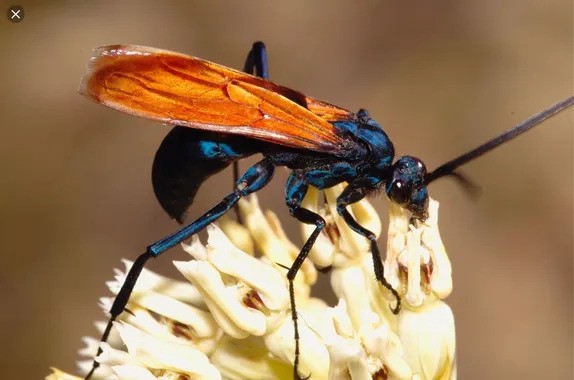
Pepsis (Tarantula Hawks)
Pepsis is a genus of large, strikingly beautiful wasps known as tarantula hawks. These wasps are part of the family Pompilidae, and they are considered some of the largest and most powerful of all wasp species. The name “tarantula hawk” comes from their predatory behavior of hunting tarantulas, which they paralyze and use as living food for their larvae. Despite their intimidating size and powerful sting, tarantula hawks are not aggressive toward humans and only sting in self-defense.
Physical Characteristics
Tarantula hawks are renowned for their impressive size and vibrant coloration. They typically range from 1 to 2 inches (25-50 mm) in length, making them one of the largest species of wasps in the world. Their bodies are often metallic blue or green, with some species displaying striking copper or orange hues. They have large, powerful wings that allow them to fly with remarkable speed and agility.
One of the most notable features of Pepsis wasps is their large size relative to their slender waists. Their long legs and wings contribute to their characteristic appearance. They also have long antennae, which they use to sense their environment, and large mandibles that they use for hunting and manipulating prey.
Behavior and Hunting
Pepsis wasps are solitary hunters, and they are best known for their unique hunting behavior. Their primary prey are tarantulas, and they engage in an intricate hunting ritual. The female tarantula hawk locates a tarantula, stings it with her powerful venom, and paralyzes the spider without killing it. This venom temporarily incapacitates the tarantula but does not kill it, keeping it alive and fresh for the wasp’s larvae to feed on.
Once the tarantula is paralyzed, the wasp drags the spider to a burrow or a safe hiding spot and lays an egg on the spider’s abdomen. The egg hatches into a larva that feeds on the living but immobilized spider. The tarantula remains alive throughout the process, but it cannot defend itself or escape from the wasp’s offspring. This predatory behavior is essential for the survival of the Pepsis wasp larvae, which rely on the living tarantula to provide them with fresh food.
Sting and Venom
The sting of a Pepsis wasp is famously painful and one of the most intense stings among insects. The venom delivered by the sting is extremely potent and causes a sharp, burning pain that can last for several minutes. Despite the excruciating pain, the sting is not deadly to humans and is not usually followed by any lasting effects, though allergic reactions are always a possibility in susceptible individuals.
The sting serves as a defense mechanism, and Pepsis wasps are generally not aggressive toward humans. They will only sting if they are directly threatened or provoked. The pain from a Pepsis sting is often described as “blinding,” and it is widely considered one of the most painful insect stings, but the pain is short-lived.
Interestingly, Pepsis wasps have been studied for the potential uses of their venom in medical science. The venom contains a variety of compounds, including neurotoxins, which may have potential applications in pain management and other therapeutic areas. However, further research is needed to fully understand its medicinal potential.
Ecological Importance
Tarantula hawks play an important role in the ecosystems they inhabit. By hunting and feeding on tarantulas, they help control spider populations and maintain a balance in the local food chain. Their hunting behavior also helps regulate the numbers of larger insects and other invertebrates, as tarantulas are often top predators in their environments.
As solitary wasps, Pepsis also contribute to pollination. While they are primarily known for their hunting habits, they occasionally visit flowers to feed on nectar, helping to pollinate plants as they move from one bloom to another.
Distribution and Habitat
Pepsis wasps are found in warm, dry environments, particularly in the southwestern United States, Central America, and parts of South America. They are often found in deserts, grasslands, and other open habitats where tarantulas are abundant. Some species are more commonly encountered in tropical and subtropical regions.
In the United States, Pepsis grossa is the most well-known species, and it can be found in areas ranging from the southwestern United States to northern Mexico. These wasps are typically active during the warmer months and are often seen flying in search of prey.
Behavior Towards Humans
Despite their intimidating appearance and powerful sting, Pepsis wasps are not aggressive toward humans. They are generally solitary and do not form colonies like other types of wasps, such as yellowjackets or hornets. Tarantula hawks are not inclined to sting unless they feel threatened, and even then, they are more likely to fly away than to engage in an attack.
If a Pepsis wasp does sting, the experience is often memorable due to the intense pain it causes. However, it is important to remember that these wasps do not seek out conflict with humans, and their stings are only a defense mechanism. Once the threat is gone, the wasp will usually go about its business of hunting tarantulas or foraging for nectar.
Life Cycle
The life cycle of a Pepsis wasp revolves around the hunting and paralyzing of tarantulas. After mating in the late summer or fall, the female hunts for a tarantula, stings it, and lays an egg on the spider’s body. The egg hatches into a larva, which feeds on the paralyzed tarantula until it is fully grown. Once the larva has consumed the spider and completed its development, it pupates and eventually emerges as an adult wasp.
The adult wasp will begin its own search for a mate and the cycle will repeat. Adult tarantula hawks live for a short period of time, generally only a few weeks, during which they mate, hunt, and lay eggs.
Conclusion
The Pepsis wasp, or tarantula hawk, is a fascinating and unique species that plays an important role in controlling spider populations and contributing to the balance of ecosystems. Their impressive size, striking appearance, and potent sting make them memorable, but despite their fearsome reputation, they are not typically aggressive toward humans. By understanding their behavior, ecology, and importance in nature, we can appreciate the role that these remarkable wasps play in the world around us.
